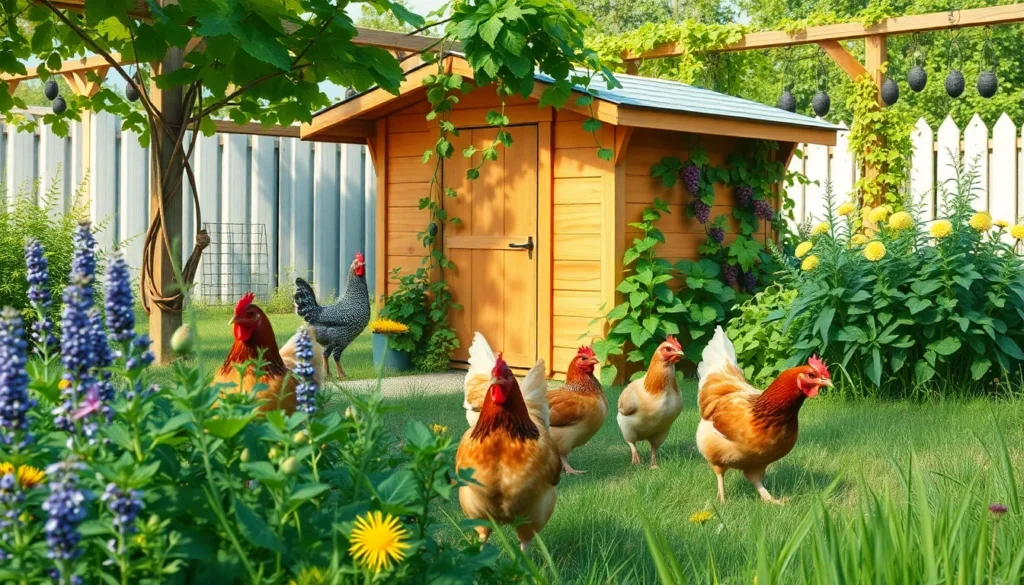We’ve all wondered how to transform our chicken coops from simple shelters into thriving ecosystems that benefit both our feathered friends and our gardens. The secret lies in choosing the right plants that’ll create a natural paradise while keeping your chickens healthy and happy.
Adding plants to your chicken coop isn’t just about aesthetics – it’s about creating a functional environment that provides natural pest control, fresh herbs for health benefits, and comfortable shade during hot summer days. The right vegetation can reduce odors, offer entertainment for your flock, and even supplement their diet with nutritious greens.
We’ll explore the best plant varieties that can withstand curious beaks and scratching claws while delivering maximum benefits for your coop setup. From aromatic herbs that repel insects to sturdy perennials that provide natural foraging opportunities, these plant selections will revolutionize your chicken-keeping experience and create the ultimate backyard sanctuary.
Choose Herbs That Naturally Repel Pests and Parasites
Smart herb selection transforms your chicken coop into a natural fortress against common parasites and flying insects. We’ll explore three powerhouse herbs that provide dual benefits as both pest deterrents and aromatic additions to your flock’s environment.
Lavender for Mite and Flea Control
Lavender stands as our top choice for combating mites and fleas that commonly plague chicken coops. The essential oils in lavender flowers contain linalool and camphor compounds that naturally repel these troublesome parasites. Planting lavender bushes around coop perimeters creates protective barriers while releasing calming fragrances.
Dried lavender bundles work exceptionally well when hung inside nesting boxes and roosting areas. Fresh stems scattered throughout bedding materials release oils gradually as chickens move around. English lavender (Lavandula angustifolia) proves most effective due to its higher oil concentration compared to other varieties.
Strategic placement maximizes lavender’s pest control benefits throughout your coop area. Position plants near coop entrances where mites typically enter, and refresh dried materials monthly for consistent protection. The purple blooms also attract beneficial pollinators that support your overall garden network.
Mint Varieties for Fly Deterrence
Mint varieties excel at keeping flies away from chicken coops through their strong menthol compounds. Spearmint and peppermint release the most potent fly repelling oils, making them ideal choices for coop landscaping. These hardy perennials spread quickly and require minimal maintenance once established.
Fresh mint leaves provide immediate fly control when crushed and scattered around feeding areas where flies congregate most. Growing mint in containers prevents aggressive spreading while allowing easy harvest for regular refreshing. Apple mint and chocolate mint offer additional aromatic options that flies find equally offensive.
Regular mint maintenance ensures continuous protection against fly populations throughout warmer months. Pinching flowers before they bloom concentrates oils in leaves for maximum deterrent effect. Rotating different mint varieties seasonally prevents flies from adapting to exact scent profiles.
Rosemary for Natural Antibacterial Properties
Rosemary delivers powerful antibacterial benefits that support overall coop hygiene and chicken health. The herb’s natural compounds including rosmarinic acid and carnosol help reduce harmful bacteria in coop environments. Fresh rosemary sprigs placed in water containers provide additional health benefits when chickens consume small amounts.
Dense rosemary bushes create excellent windbreaks while releasing antibacterial oils into surrounding air. These evergreen plants thrive in various climates and require little water once established. Pruning rosemary regularly provides fresh material for coop use while maintaining plant health and shape.
Combining rosemary with other herbs amplifies its antibacterial effectiveness in chicken environments. Mixing dried rosemary with lavender and mint creates potent herbal blends for nesting boxes. The needle like leaves also deter rodents that might otherwise invade feed storage areas near coops.
Select Ground Cover Plants That Withstand Heavy Foot Traffic
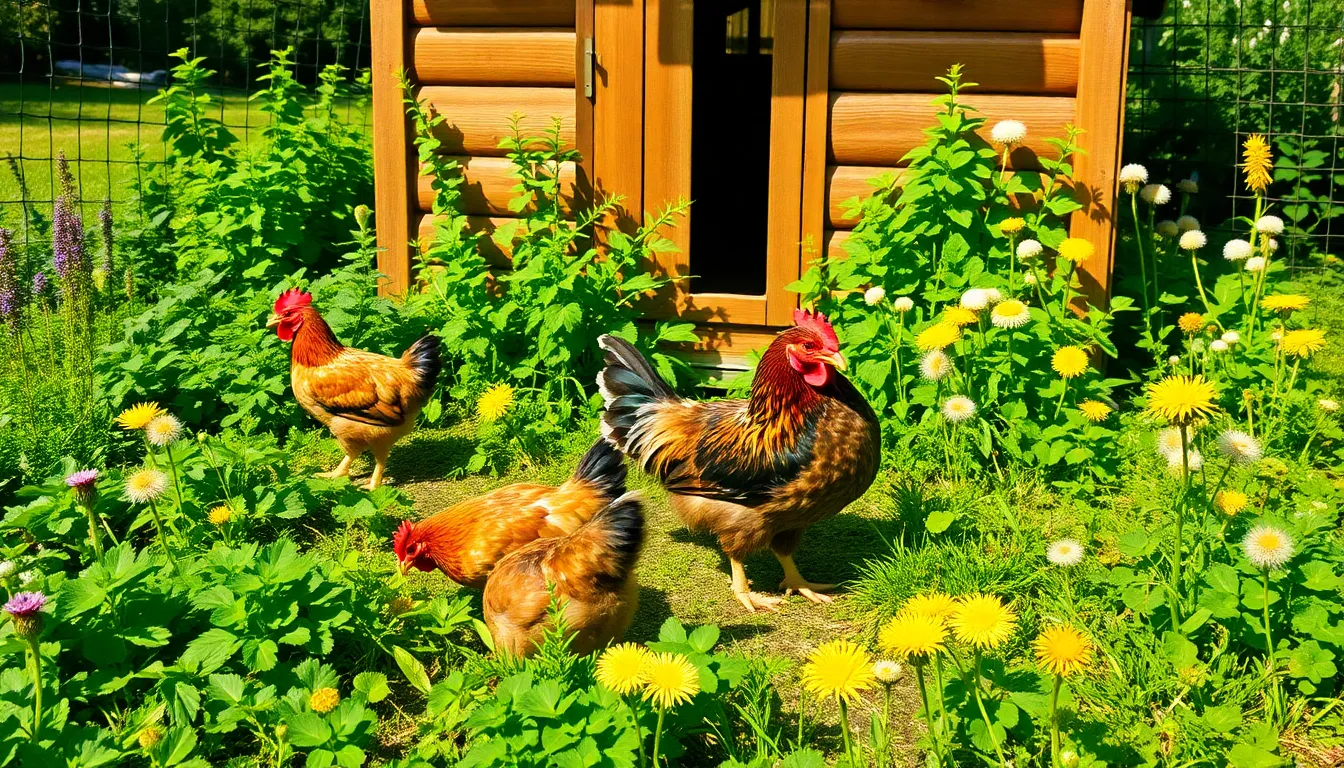
Chickens create unique challenges for ground cover with their constant scratching and pecking behaviors. We need plants that can recover quickly from heavy use while providing valuable benefits to our feathered friends.
Clover for Nitrogen Fixing and Durability
White clover stands out as our top choice for chicken run ground cover because it tolerates heavy foot traffic exceptionally well. This hardy legume recovers quickly after being nibbled by chickens while serving as a nutritious forage source high in protein. Also, white clover fixes nitrogen naturally in the soil, enriching the ground around our coop without expensive fertilizers.
Living mulch benefits emerge when we establish clover throughout the chicken run area. Our chickens enjoy supplementing their diet with this protein rich plant while the clover continues to grow even though constant attention. Growth patterns allow white clover to spread naturally and fill bare spots that develop from regular chicken activity.
Plantain for Medicinal Benefits and Resilience
Plantain thrives in high traffic areas and offers remarkable medicinal properties for our chickens. This tough perennial withstands constant pecking and scratching while providing natural anti inflammatory benefits when consumed. Wound healing properties make plantain particularly valuable as chickens occasionally suffer minor cuts or scrapes during their daily activities.
Natural health support comes from allowing our chickens to self medicate with plantain as needed. We often find this resilient plant growing wild in chicken runs, demonstrating its ability to survive harsh conditions. Establishment requires minimal effort since plantain adapts to various soil types and growing conditions around our coops.
Dandelions for Year-Round Foraging
Dandelions provide consistent foraging opportunities throughout multiple seasons for our chicken flocks. These hardy perennials offer edible leaves, flowers, and roots that support digestive health while providing essential vitamins our chickens need. We find dandelions thrive best in moist soil with partial shade, though they grow successfully in various locations around our property.
Nutritional benefits include vitamins A, C, and K along with minerals that supplement our chickens’ regular feed. Free ranging chickens actively seek out dandelion greens, demonstrating their natural preference for this beneficial plant. Year round availability means our chickens can access fresh nutrients even during seasons when other forage options become scarce.
Plant Edible Flowers That Boost Egg Quality
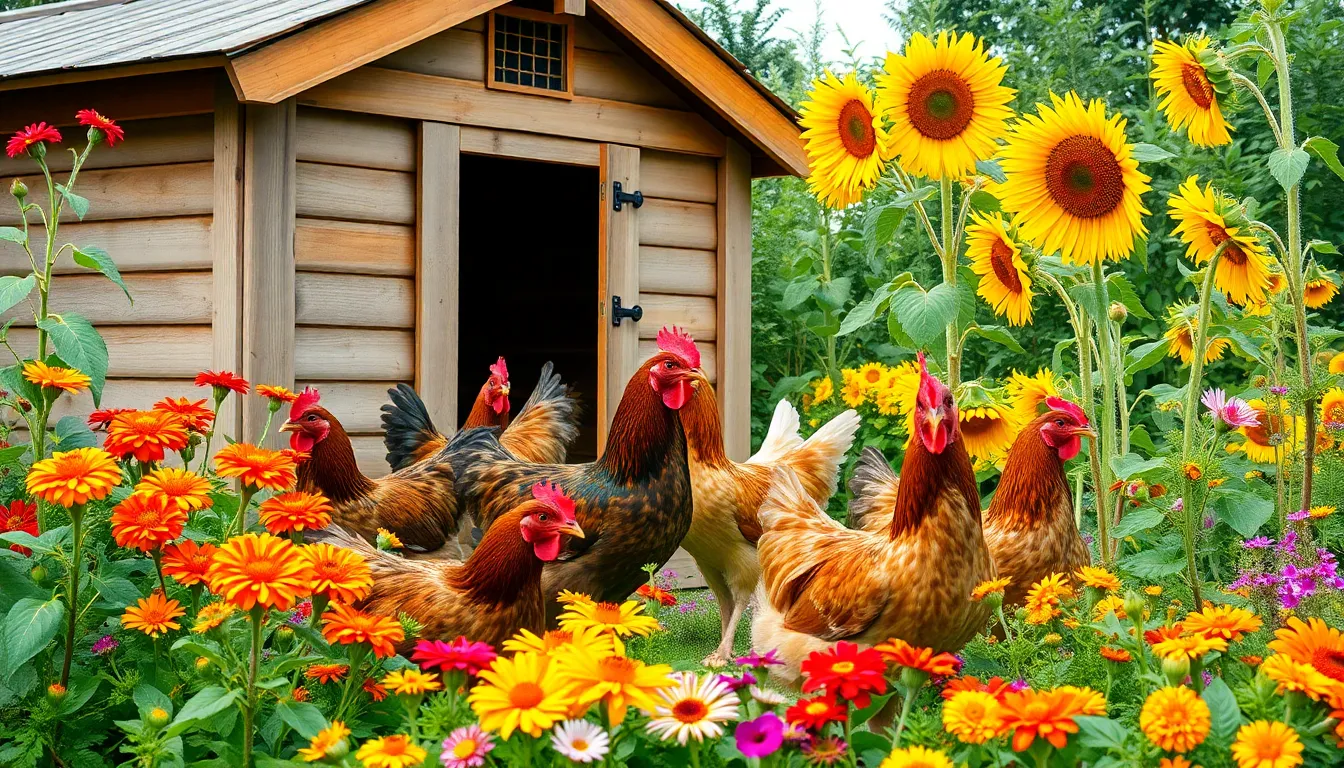
Adding colorful, edible flowers to your chicken coop creates a beautiful environment while directly improving egg quality and supporting your flock’s health. We’ve identified the most effective flowering plants that offer proven benefits backed by research.
Calendula for Enhanced Yolk Color
Calendula flowers deliver exceptional benefits for both egg quality and chicken immunity. These bright orange blooms naturally enhance yolk color, creating deeper, richer yellow eggs that are more visually appealing and nutritionally dense. Studies show that calendula petals contain antioxidants and nutrients that support immune function while reducing inflammation in chickens.
We recommend incorporating calendula into your chickens’ diet by scattering fresh petals in their feed or placing dried flowers in nesting boxes. The natural compounds in calendula soothe skin irritations and boost overall immunity, making your flock more resistant to common health issues. Marigold flower extracts have been proven to improve yolk color significantly and can even lower cholesterol levels in eggs, improving both aesthetic and nutritional quality.
Nasturtiums for Natural Antibiotic Properties
Nasturtiums provide natural antibiotic and antimicrobial properties that support your chickens’ immune systems. These vibrant flowers contain compounds that may help reduce infections and promote overall flock health. Planting nasturtiums around your chicken coop creates a natural defense system against harmful bacteria while adding beautiful color to your garden.
We suggest allowing your chickens to forage on nasturtium leaves and flowers freely, as both parts of the plant offer health benefits. The peppery flavor of nasturtiums can stimulate appetite and digestion in chickens, while their antimicrobial properties work to maintain gut health. Strategic placement of nasturtium plants near feeding areas encourages natural foraging behavior while delivering therapeutic benefits.
Sunflowers for Healthy Fats and Entertainment
Sunflowers serve dual purposes in chicken coops by providing essential healthy fats and creating natural entertainment for your flock. These towering plants offer nutritious seeds that support hen health and wellbeing through their high fat content. Sunflower seeds contribute to improved feather quality and overall vitality in chickens.
We encourage planting sunflowers directly in chicken runs or near coop areas to promote natural foraging behavior. Chickens enjoy pecking at sunflower heads, which provides mental stimulation and physical exercise while delivering nutritional benefits. Fresh sunflower seeds can be scattered as treats, or you can allow mature flower heads to remain on plants for extended foraging opportunities that keep your flock engaged and healthy.
Install Climbing Vines for Natural Shade and Privacy
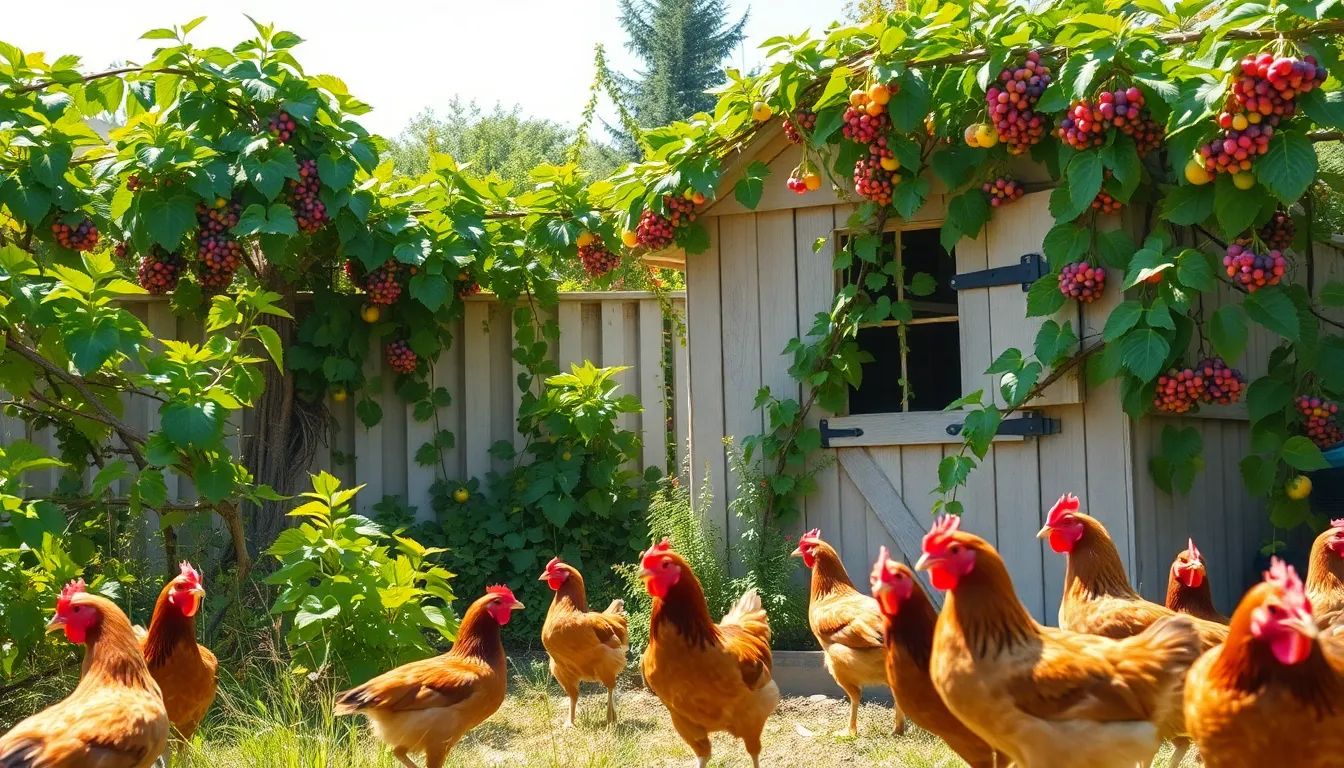
Climbing vines create natural coverage around your coop while providing functional benefits that extend beyond simple aesthetics. These vertical growing plants offer temperature regulation and stress reduction for your flock through strategic placement and species selection.
Grape Vines for Fruit Production and Coverage
Grape vines deliver dual benefits that maximize space utilization in backyard poultry setups. We recommend training these vines to cover coop exteriors or trellises where they’ll create dense foliage for effective shading.
The productive nature of grape vines means you’ll harvest fresh fruit for your family while your chickens benefit from the cooling shade below. Dense grape foliage naturally moderates temperature extremes throughout the seasons. Your grape selection should focus on hardy varieties that thrive in your climate zone and can withstand occasional chicken interaction with lower vine sections.
Establishing grape vines requires sturdy support structures since mature vines carry important weight when fully loaded with fruit and foliage. We suggest installing reinforced trellises or pergolas that can handle both vine weight and potential chicken perching behavior.
Berry Bushes for Seasonal Treats
Berry bushes enhance your chickens’ diet while encouraging natural foraging behaviors throughout growing seasons. Strategic placement of these bushes around coop perimeters creates natural barriers that offer both protection and nutrition for your flock.
Seasonal fruit production from berry bushes provides chickens with vitamin rich treats during peak growing periods. We’ve observed that chickens naturally gravitate toward berry bushes during fruiting seasons, making these plants excellent additions to free range areas. Your berry selection should include varieties that fruit at different times to extend the natural treat season.
Maintenance requirements for berry bushes remain minimal while offering maximum benefit to both chickens and human families. Most berry varieties establish quickly and provide years of productive harvests with basic pruning and care. We recommend planting berry bushes just outside immediate coop areas where chickens can access fallen fruit without damaging the root systems.
Hops for Natural Calming Effects
Hops contribute to flock welfare by creating relaxed environments that reduce stress related behaviors in chickens. The calming properties of hops help soothe anxious birds and promote overall coop harmony during times of environmental changes or flock adjustments.
Natural stress reduction becomes particularly valuable during seasonal transitions, new bird introductions, or weather related confinement periods. We’ve found that hops planted near coop areas contribute to calmer flock dynamics and reduced pecking behaviors. Your hop installation should consider climbing support since these vines grow vigorously and require adequate space for full development.
Harvesting opportunities from hop vines extend benefits beyond chicken keeping for families interested in brewing or herbal applications. The dual purpose nature of hops makes them valuable additions to integrated backyard systems where space optimization matters most.
Incorporate Dust Bath Plants That Promote Hygiene
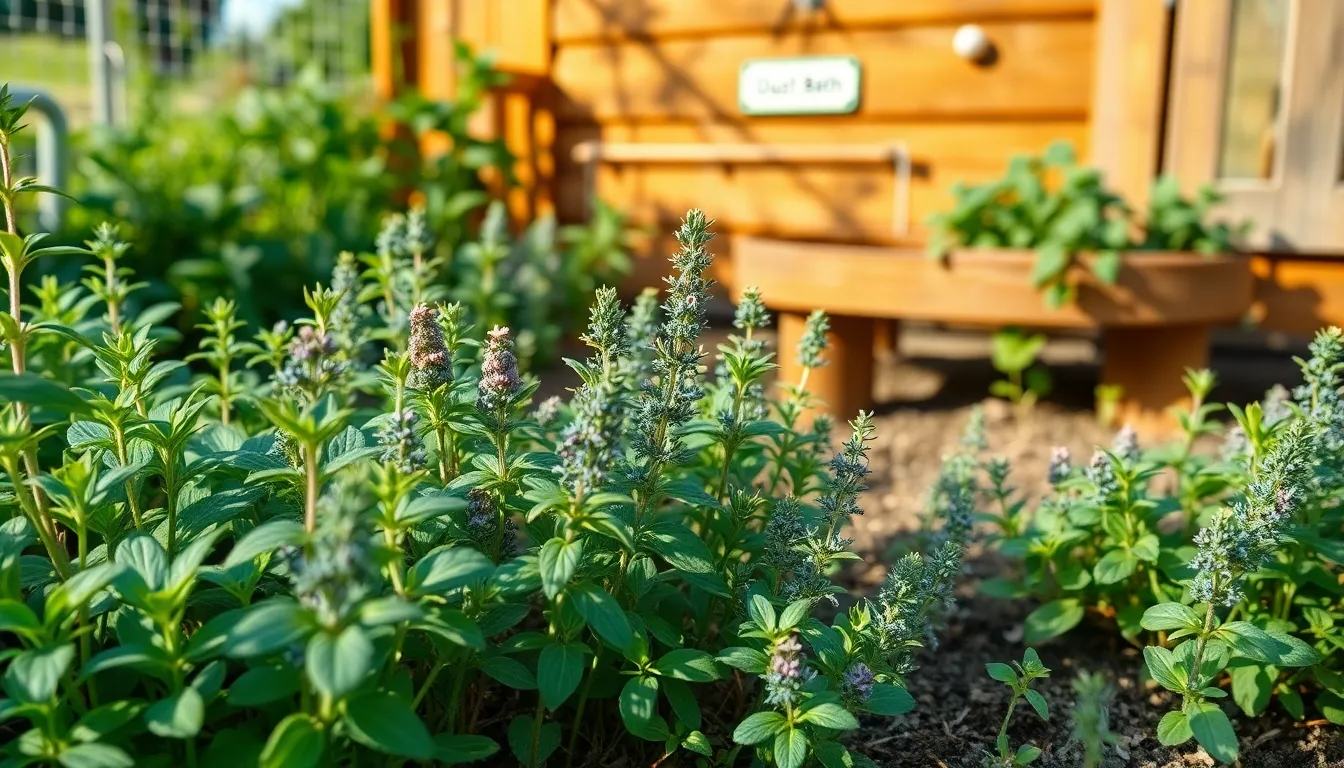
Dust bathing provides essential skin and feather health maintenance for our chickens, helping them naturally remove parasites and excess oils. We can enhance this natural behavior by strategically planting exact herbs near dust bath areas that offer additional hygiene benefits.
Wormwood for Parasite Prevention
Wormwood stands out as our most effective natural parasite deterrent for chicken coops. Growing Artemisia absinthium near dust bath areas creates a protective barrier against internal and external parasites that commonly plague backyard flocks. We’ve found that this hardy perennial naturally repels mites and worms without requiring chemical interventions.
Planting wormwood around the perimeter of dust bath zones maximizes its protective benefits. The herb’s natural compounds release into the air and surrounding soil, creating an environment that parasites actively avoid. We recommend establishing small clusters of wormwood plants at 3 to 4 foot intervals around designated dust bath areas.
Maintenance requirements for wormwood remain minimal throughout the growing season. This drought tolerant plant thrives in poor soil conditions and requires little water once established. We can expect wormwood to return year after year, providing consistent parasite prevention with virtually no ongoing care.
Sage for Antimicrobial Properties
Sage delivers powerful antimicrobial protection when planted strategically near chicken dust baths. Salvia officinalis naturally inhibits harmful bacteria that can compromise our flock’s immune system and overall health. We benefit from sage’s dual purpose as both a protective plant and occasional foraging opportunity for our chickens.
Growing sage in raised beds or containers near dust bath areas ensures optimal placement and control. This Mediterranean herb prefers well drained soil and full sun exposure, making it perfect for areas where chickens create their bathing spots. We can harvest sage leaves regularly without impacting the plant’s antimicrobial benefits for our flock.
Regular pruning of sage plants maintains their potency and encourages new growth. Cutting back flowering stems redirects the plant’s energy into producing the essential oils responsible for antimicrobial properties. We recommend harvesting sage every few weeks during the growing season to keep plants productive and beneficial.
Thyme for Respiratory Health Benefits
Thyme provides exceptional respiratory support through its natural antibacterial and antibiotic properties. Thymus vulgaris growing near dust bath areas releases beneficial compounds that help chickens fight respiratory infections effectively. We can rely on thyme’s proven track record for supporting lung health in poultry naturally.
Establishing thyme groundcover around dust bath zones creates a living carpet of medicinal benefits. This low growing herb spreads naturally and tolerates moderate foot traffic from our chickens’ daily activities. We’ll notice thyme’s aromatic oils become more concentrated when chickens brush against the plants during dust bathing sessions.
Multiple thyme varieties offer different levels of medicinal potency for respiratory health. Common thyme provides strong antibacterial action, while lemon thyme adds antimicrobial properties with a gentler fragrance. We can plant different varieties in succession to ensure year round respiratory support for our flock.
Position Trees That Provide Shelter and Foraging Opportunities
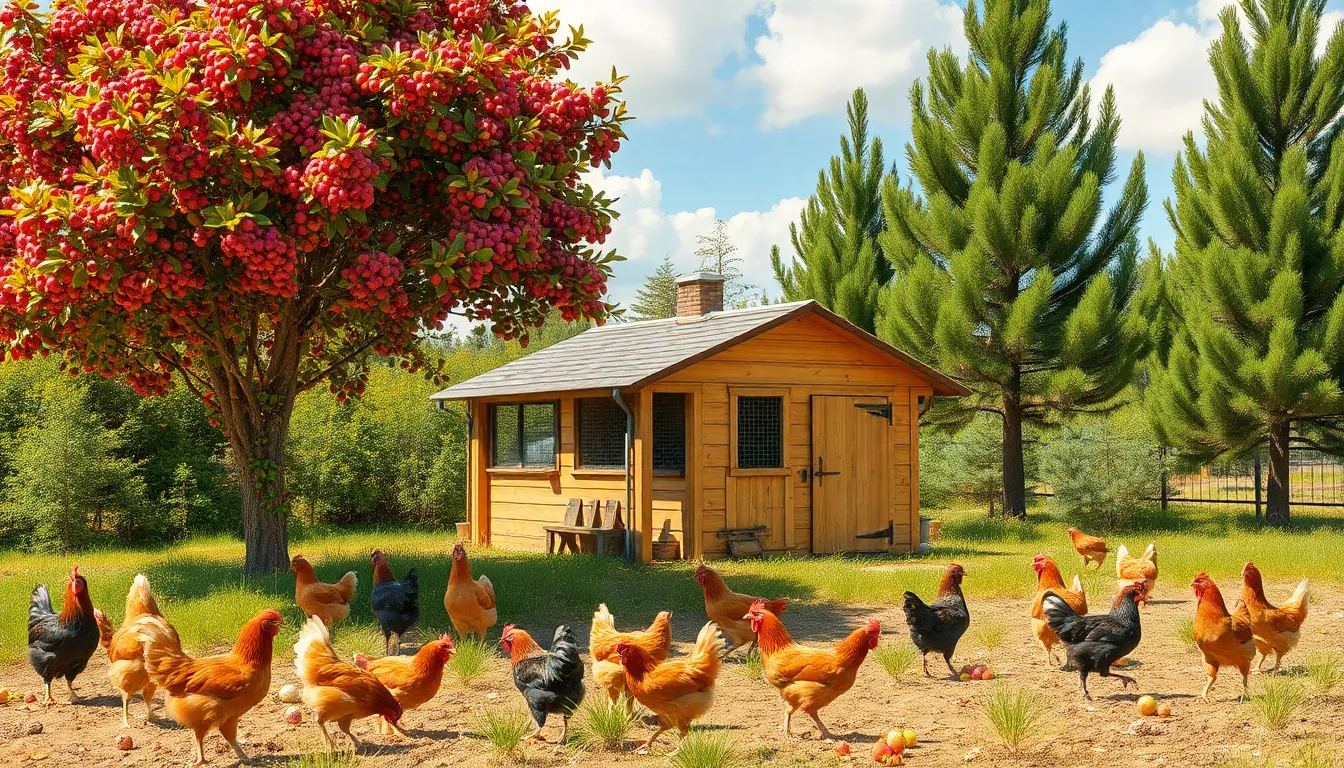
Strategic tree placement around your chicken coop creates natural shelter while providing valuable foraging opportunities throughout the year. We’ll explore three essential tree types that offer maximum benefits for both chicken comfort and nutrition.
Mulberry Trees for Protein-Rich Berries
Mulberry trees transform into large shady canopies that provide excellent cover and hiding spots for your flock. These deciduous giants offer the perfect balance by allowing winter sunlight to reach your coop area while reducing harmful parasite buildup in the soil during warmer months.
Chickens eagerly consume fallen mulberries as protein-rich treats that supplement their regular diet. Your birds will also nibble on the nutrient-dense leaves, adding variety to their foraging experience. The relationship becomes mutually beneficial since chicken droppings serve as natural fertilizer for the trees, creating a sustainable network.
Positioning mulberry trees on the south or west side of your coop maximizes summer shade while ensuring adequate winter light penetration. We recommend planting them at least 10 feet from your coop structure to allow proper root development and prevent damage to your buildings.
Apple Trees for Seasonal Fruit Drops
Apple trees deliver consistent seasonal benefits through natural fruit drops that chickens absolutely love to forage. The fallen apples provide moisture-rich treats packed with essential nutrients that support overall flock health and egg production quality.
Summer shade coverage from apple trees creates comfortable resting areas for your chickens during hot weather. Winter’s dappled sunlight filtering through bare branches maintains the perfect balance of warmth and protection. The tree structure offers natural perching spots and hiding spaces that enhance your coop’s habitat diversity.
Plant dwarf apple varieties if space is limited, as they still produce substantial fruit while requiring less maintenance. Position apple trees where falling fruit won’t create cleanup issues near feeding areas, typically 8 to 12 feet from your main coop entrance.
Pine Trees for Natural Windbreaks
Pine trees serve as living windbreaks that shield your chickens from harsh weather conditions year-round. Their dense evergreen foliage creates effective barriers against strong winds and driving rain that can stress your flock and damage coop structures.
These hardy trees maintain their protective qualities throughout all seasons, providing consistent shelter when chickens need it most. The stable microclimate they create helps regulate temperature fluctuations around your coop area, improving overall chicken comfort and reducing energy loss.
Strategic placement of pine trees on the north and west sides of your property blocks prevailing winter winds most effectively. We suggest planting them in rows or clusters at least 20 feet from your coop to maximize wind protection while preventing needle accumulation in chicken areas.
Establish Medicinal Plants for Natural Health Support
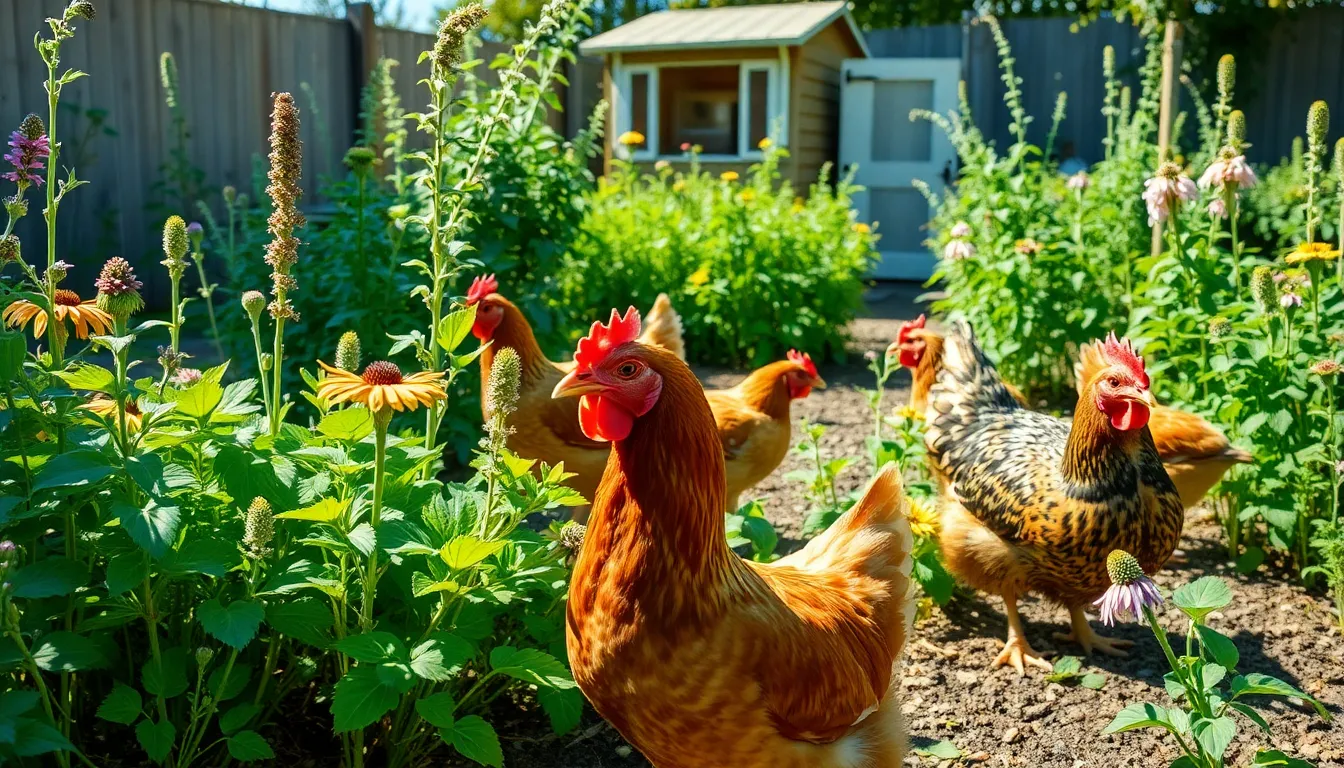
Building on our comprehensive coop network, we can further enhance our flock’s wellbeing by incorporating plants that offer exact therapeutic benefits. Strategic placement of medicinal herbs creates a natural pharmacy that supports immune function, digestive health, and wound recovery.
Echinacea for Immune System Boosting
Echinacea strengthens our chickens’ natural defenses against common pathogens and seasonal illnesses. This purple flowering herb acts as an immune stimulant, helping our flock resist infections more effectively throughout the year.
Plant echinacea in well-draining soil near the coop perimeter where chickens can access the leaves and flowers during free-range time. The herb thrives in full sun to partial shade, making it adaptable to various locations around our chicken area.
Harvest echinacea leaves and flowers during peak growing season to dry for winter supplementation. We can add dried echinacea to our chickens’ feed or sprinkle fresh leaves in their run to provide consistent immune support.
Oregano for Digestive Health
Oregano delivers powerful antimicrobial properties that support our flock’s digestive system and respiratory health naturally. This aromatic herb contains compounds that aid digestion while helping prevent illness in our chickens.
Establish oregano plants in containers or designated garden beds near the coop for easy access and controlled growth. The herb spreads readily, so containerization prevents it from overtaking other medicinal plants in our chicken garden.
Encourage natural foraging by allowing chickens to nibble fresh oregano leaves throughout the growing season. We can also harvest and dry oregano to mix into their regular feed during winter months when fresh herbs aren’t available.
Comfrey for Wound Healing Properties
Comfrey accelerates tissue repair and reduces inflammation, making it invaluable for treating minor injuries our chickens might sustain. This leafy perennial contains natural compounds that promote healing while supporting better digestion.
Position comfrey plants strategically in areas where chickens frequently roam but won’t completely destroy the root system. The herb’s deep taproot makes it resilient to moderate chicken activity while providing continuous leaf production.
Create natural first aid stations by growing comfrey near dust bath areas where chickens might encounter minor scrapes or irritations. Fresh comfrey leaves can be applied directly to wounds, while chickens instinctively consume the leaves to support internal healing processes.
Conclusion
We’ve explored how the right plant choices can transform our chicken coops into thriving ecosystems that benefit both our flocks and ourselves. From pest-repelling herbs like lavender and mint to nutritious ground covers like white clover and plantain we now have a comprehensive toolkit for creating healthier environments.
The combination of edible flowers climbing vines and medicinal plants offers multiple layers of benefits that extend far beyond basic functionality. These strategic plantings provide natural healthcare dust bath enhancements and foraging opportunities that support our chickens’ instinctual behaviors.
By implementing these plant-based answers we’re not just improving our chickens’ quality of life – we’re creating sustainable low-maintenance systems that work with nature rather than against it. Our coops become productive spaces where every element serves a purpose contributing to healthier happier flocks and more rewarding chicken-keeping experiences.
Frequently Asked Questions
What plants are best for natural pest control around chicken coops?
Lavender, mint varieties (spearmint and peppermint), and rosemary are excellent choices for pest control. Lavender repels mites and fleas with its essential oils, mint keeps flies away, and rosemary provides antibacterial properties that support coop hygiene. These herbs create a protective environment while offering calming fragrances and health benefits for your flock.
Which ground cover plants can withstand chicken traffic?
White clover, plantain, and dandelions are ideal ground cover options. White clover is durable and fixes nitrogen in soil while providing nutritious forage. Plantain offers resilience and medicinal anti-inflammatory properties. Dandelions provide year-round foraging with essential vitamins and minerals that support digestive health, making them perfect for high-traffic chicken areas.
How do edible flowers benefit chicken health and egg quality?
Calendula flowers enhance yolk color and boost immunity, while nasturtiums provide natural antibiotic properties for overall flock health. Sunflowers offer nutritious seeds and encourage natural foraging behavior. These flowering plants not only beautify the coop but also provide significant nutritional benefits that improve egg quality and support chicken wellness.
What climbing plants work well for chicken coop shade?
Grape vines are excellent for providing natural shade and privacy while maximizing space. They offer cooling shade for chickens and produce fruit for human consumption. Install sturdy support structures to accommodate their weight. Berry bushes also work well, providing seasonal treats and encouraging natural foraging behaviors with minimal maintenance requirements.
Which plants help with chicken dust bath hygiene?
Wormwood, sage, and thyme are excellent dust bath plants. Wormwood acts as a natural parasite deterrent when planted near dust bath areas. Sage provides powerful antimicrobial properties for flock health, while thyme offers respiratory health benefits. These herbs create a protective barrier and enhance overall hygiene in dust bath zones.
What trees should I plant around my chicken coop?
Mulberry trees provide protein-rich berries and shade, apple trees offer seasonal fruit drops for flock health, and pine trees serve as natural windbreaks. Plant trees at proper distances to maximize benefits while ensuring healthy growth. Each tree type provides specific advantages like nutrition, comfort, and weather protection for your chickens.
How can medicinal plants support my flock’s health?
Echinacea boosts immune systems, oregano supports digestive health with antimicrobial properties, and comfrey accelerates wound healing while reducing inflammation. These medicinal plants create a natural pharmacy around your coop. Strategic placement and proper harvesting ensure your chickens benefit from these healing herbs throughout the year for optimal wellness.

